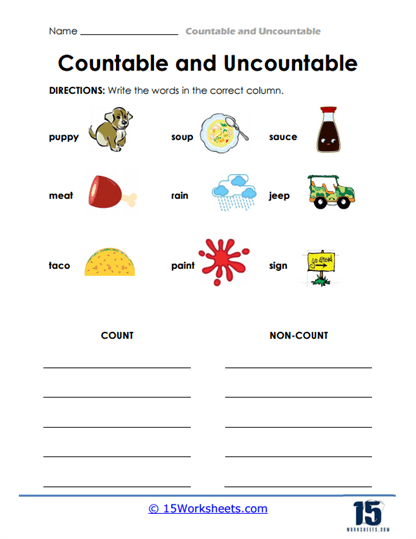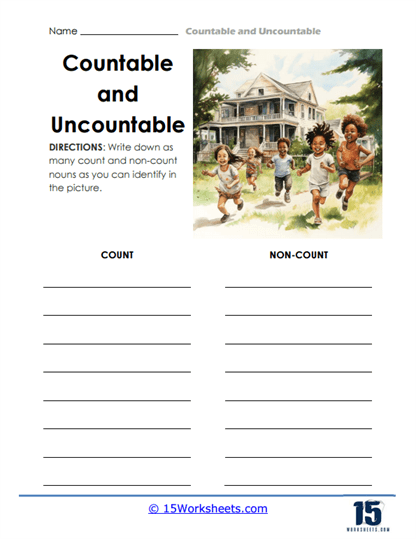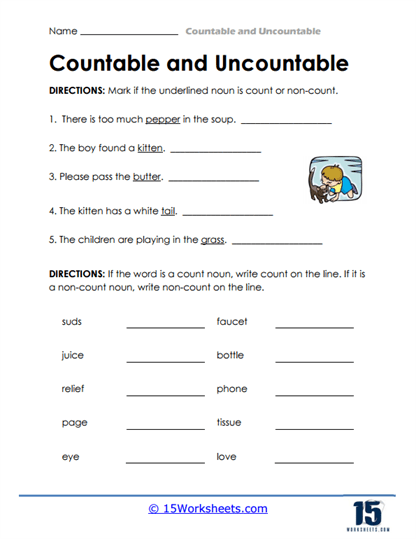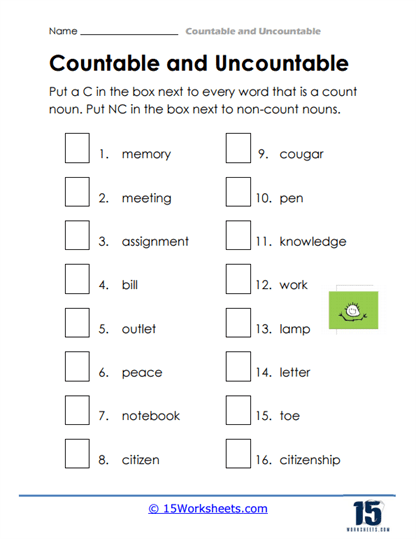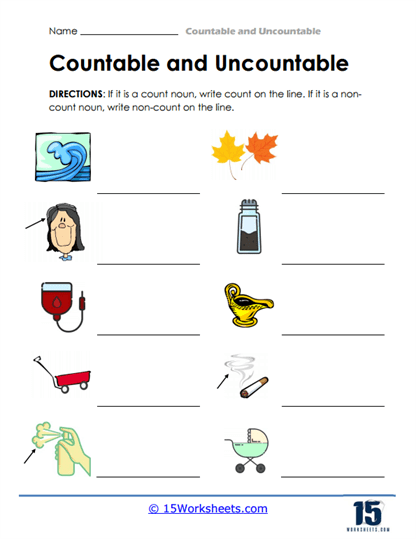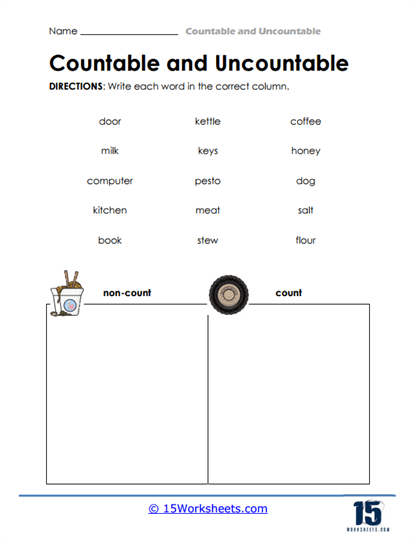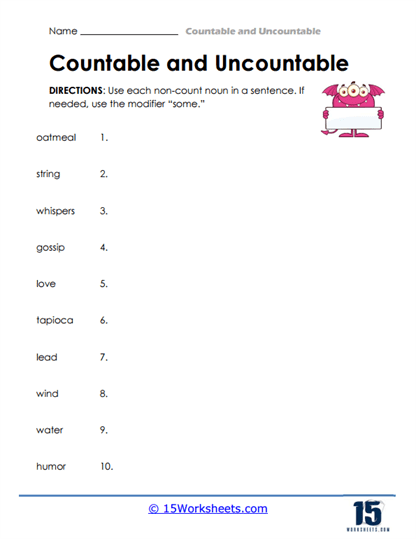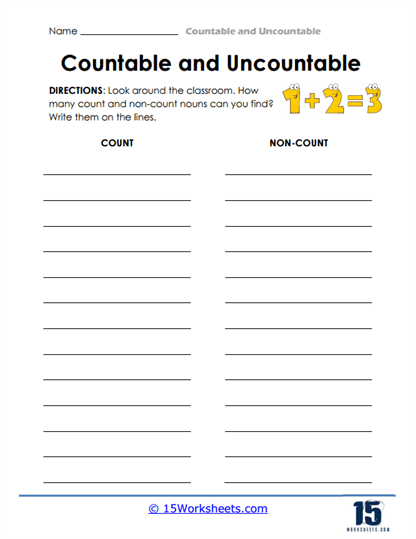Countable And Uncountable Nouns Worksheets
About These 15 Worksheets
This worksheet series offers a comprehensive and engaging approach to teaching young learners the difference between countable and uncountable nouns. As a professional teacher specializing in early childhood education, I understand the importance of solidifying foundational grammar concepts in a way that is both fun and educational. This collection of worksheets does just that by using a variety of activities designed to capture the attention of young students while reinforcing essential language skills.
These worksheets are available in PDF format, making them incredibly easy to access, download, and print. This convenience allows for seamless integration into any lesson plan, whether you’re teaching in a classroom setting or supporting learning at home. The activities are designed to cater to different learning styles, ensuring that every child can grasp the concept of countable and uncountable nouns effectively.
One of the standout features of this collection is its visual appeal. Each worksheet is colorful and filled with engaging images that make learning enjoyable. For instance, one worksheet prompts students to identify and categorize objects as countable or uncountable by looking at pictures, such as fish, jars of candy, and stacks of coins. This activity helps students visually distinguish between items that can be counted individually and those that are considered a whole or mass, providing a strong foundation in understanding these grammatical categories.
Another worksheet encourages students to cut out pictures of various objects and place them into the correct columns labeled “Count Nouns” and “Non-Count Nouns.” This hands-on activity not only reinforces the concept but also helps improve fine motor skills as students cut and sort the images. By physically manipulating the images, students can better internalize the difference between countable and uncountable nouns, making the learning experience more tactile and memorable.
Further extending the variety of activities, some worksheets challenge students to read lists of words and decide whether each one is countable or uncountable. This activity enhances their vocabulary and word recognition skills, all while reinforcing the lesson’s main objective. Additionally, other worksheets ask students to write sentences using non-count nouns, encouraging them to apply their knowledge in a practical context. This activity is particularly effective in helping students understand how to use these nouns in everyday language, thereby improving their writing and speaking skills.
Another unique aspect of this collection is the inclusion of worksheets that focus on the use of modifiers with countable and uncountable nouns. Students are asked to fill in the blanks with appropriate modifiers like “some,” “a,” “an,” or specific numbers, depending on the noun in question. This not only reinforces their understanding of the nouns themselves but also teaches them about the correct usage of quantifiers and articles, which is an essential aspect of grammar.
There are worksheets where students must observe a picture and list all the countable and uncountable nouns they can identify. This open-ended activity encourages critical thinking and observational skills as students analyze the image and apply their knowledge independently. It also provides an opportunity for teachers to assess their students’ understanding in a more holistic way.
In addition to these activities, the worksheets include exercises that require students to distinguish between countable and uncountable nouns within sentences. For example, students might be asked to underline the noun and then determine its category. This helps reinforce the lesson in a context that mirrors real-world language use, further solidifying the concept in the student’s mind.
The collection also includes creative writing prompts where students must use countable and uncountable nouns in sentences, enhancing their ability to express themselves while adhering to grammatical rules. These prompts stimulate creativity and allow students to practice their language skills in a structured yet imaginative way.
The variety of activities ensures that learners remain engaged, while the visually appealing and interactive nature of the worksheets makes the learning process enjoyable. Whether used in the classroom or at home, these worksheets provide a solid foundation in grammar that will benefit students in their future language studies.
What Are Countable and Uncountable Nouns?
Countable and uncountable nouns are fundamental concepts in English grammar that help us understand how to quantify and refer to various objects and substances. Countable nouns refer to items that can be counted as individual units. They can be singular or plural, and they typically take an article such as “a” or “an” when singular (e.g., “a book,” “an apple”) and often an “s” or “es” to form the plural (e.g., “two books,” “three apples”). Countable nouns include things like “chair,” “dog,” or “car,” which are tangible and can be easily counted.
On the other hand, uncountable nouns refer to substances, concepts, or masses that cannot be separated into individual units and therefore cannot be counted directly. These nouns typically do not have a plural form and do not take the articles “a” or “an.” Instead, they are often preceded by quantifiers such as “some,” “much,” or “a little.” Examples of uncountable nouns include “water,” “rice,” “information,” and “happiness.” These words represent things that are usually seen as wholes or abstract concepts, making them impossible to count in discrete numbers.
When using countable and uncountable nouns in sentences, it’s important to choose the appropriate articles and quantifiers. For instance, you might say, “I have a book,” using “a” to refer to one countable item. If you have more than one, you could say, “I have three books.” In contrast, with uncountable nouns, you would say, “I need some water,” or “There is a lot of information available,” using “some” or “a lot of” to refer to an unspecified quantity that cannot be counted individually. Understanding the difference between these types of nouns and how to use them correctly in sentences is crucial for achieving accuracy and fluency in English.






